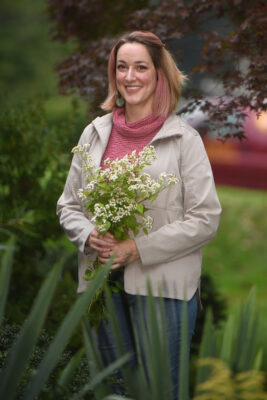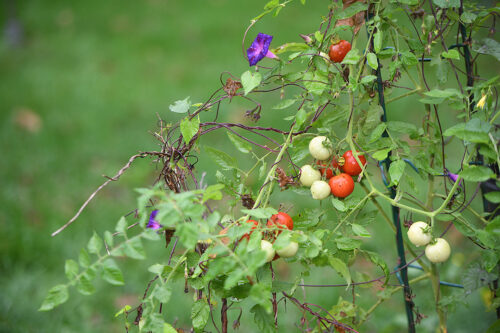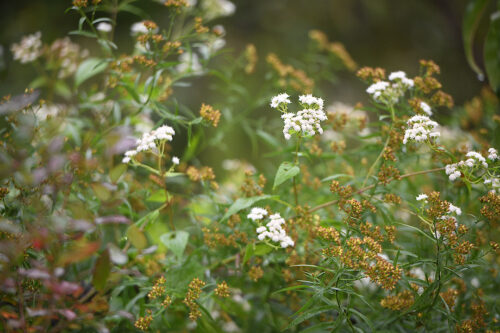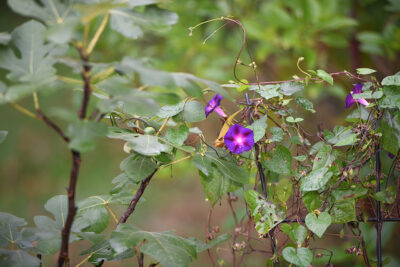
PHOTOS BY DONNA MUELLER
Briarcliff Manor is getting more green. And more purple, yellow, and orange too.
The village recently planted a variety of pollinator plants, such as purple cone-flowered echinacea, black-eyed Susans, and orange-flowered milkweed to attract butterflies, in the area outside the Briarcliff Village Hall.
The plants “attract pollinators and they’re good for the environment,” said Dr. Amy Karpati, chair of the new Briarcliff Environmental Advisory Council (EAC). *The EAC was established by the village in Fall, 2022, succeeding the horticulture committee, with the mission of preserving and planting trees and indigenous flora in the central business district, in town parks and on walkways, walking trails and green spaces, and educating residents on garden cultivation, sustainable landscaping and pest control.
Working with the EAC, the village planted 30 to 35 native trees in parks and around the village’s youth center on Lu Van Lu Road and will determine where to plant new trees in the so-called “Tree Streets” neighborhood (including Oak, Maple, and Larch roads), to mitigate the potential for flooding.
 “We need more trees to help with stormwater control and to help stabilize soils. Several tributaries of the Pocantico River run through Briarcliff and they can flood. Pocantico River goes through Jackson Road Park and the neighborhood bordering it.”
“We need more trees to help with stormwater control and to help stabilize soils. Several tributaries of the Pocantico River run through Briarcliff and they can flood. Pocantico River goes through Jackson Road Park and the neighborhood bordering it.”
Possible tree species that could be planted include Swamp White Oak and River Birch, Karpati said.
These are trees “that can grow in areas that are intermittently wet and dry. There’s a general acknowledgement that we need more trees. The village asks us what species (of tree) we’d recommend,” she explained. “We’re collaborating with the village on future tree planting projects, providing guidance and recommendations on which species to plant and where to plant them.”
Karpati is an adjunct professor in the graduate sustainability management program at Columbia University. She earned a PhD in ecology and evolution from Rutgers.
“Briarcliff has a renewed interest in sustainability,” Karpati pointed out. “What I would love to see happen is to make Briarcliff a model of suburban sustainability,” she said, where the village makes “green spaces that are connected and walkable and bike-able. Briarcliff can remodel the streetscape and make it climate-resilient.”
In an email, Karpati described her vision in more detail: “I think it is important for the EAC – and the village – to really think outside of the box and think about what is possible regarding nature and natural resources in our community. We can bring nature into the places we live and work. In this way, we can have a two-pronged approach to conservation and sustainability, in which we, one, protect the existing forests, natural areas and green spaces and two, enhance biodiversity and ecosystem function within our built environment, reconciling our needs with the needs of other species, even in business districts and downtown streetscapes. We can protect what we already have and also create more nature. This would mean thinking about green infrastructure and nature-based solutions: green roofs, vegetated stormwater swales, street trees, rain gardens, pollinator gardens, etc.”
 Another area of the EAC’s focus will be sustainable landscaping.
Another area of the EAC’s focus will be sustainable landscaping.
“We advocate for reducing the area of your lawn in favor of wildflower meadow habitat,” Karpati said. “We hope to provide more training in 2024 on how to get rid of grass, how to put in plants that are good for wildflower meadows, and how to make your yard more eco-friendly and sustainable. The blatant use of pesticides contributes to the decline in birds, bees, and moths,” she explained.
Native wildflowers and native grasses have roots that penetrate deep into the soil, which means they are more able to reach water sources. This makes them more drought resistant than turf grass, such as Kentucky blue grass, which has shallow roots. Turf grass needs more water and is susceptible to drying out.
“Lawns have so much potential for nature conservation,” she said.
One of the critical issues with current lawn care practices is the disposal of leaf litter every autumn. Firefly, butterfly, and moth larvae bury themselves in leaf litter, Karpati said. When homeowners gather up and throw away their leaf litter, they’re also throwing out the larvae. That’s how these species disappear from your lawn.
Moths and butterflies are important pollinator species. Concerning fireflies, “they have significant ecological and cultural value,” Karpati wrote in an email. “Ecologically, they are beneficial insects, as the larvae are voracious predators that gobble up snails and slugs, benefiting gardens and agricultural lands. Culturally, they are emblematic of childhood summers. Their twinkling bioluminescence is a source of wonder for kids and adults and connects us to the nature around us.
“They can be good ambassadors for suburban conservation, as their populations have been in decline, and it would be quite a shame to lose them from our neighborhoods,” she stated.
Karpati grew up on Long Island and frequently went on camping trips with her family, which helped her develop a connection with nature early in her childhood. She has worked as a director of science and programs at the Teatown Lake Reservation in Ossining and a conservation biologist and environmental advocate in the New Jersey Pinelands.
At Columbia, she teaches how to create sustainable environments in urban areas, building green infrastructure in cities and enhancing biodiversity. She explained the presence of pigeons in cities, a question many walkers face every day as they make their way through New York City.
 “The reason why they (pigeons) thrive is that tall buildings mimic the steep rock cliff sides that are their native habitats,” she said.
“The reason why they (pigeons) thrive is that tall buildings mimic the steep rock cliff sides that are their native habitats,” she said.
“I’m fascinated with how nature works. It’s cool to research how species adapt to their urban environments and how to bring ecosystem management back into disturbed landscapes.”
*Briarcliff Environmental Advisory Council: Dr. Amy Karpati, Brooke Beebe, Ernie DeMarie, Steven Kavee and Dawn Orza
 Joined by Town of Ossining Supervisor Dana Levenberg, Town of Yorktown Supervisor Matt Slater, and Mike Weinberg from State Senator Pete Harckham’s staff, Teatown Executive Director Kevin Carter and Director of Science and Stewardship Dr. Danielle Begley-Miller spoke about the importance of the project, and what it meant for Teatown moving forward.
Joined by Town of Ossining Supervisor Dana Levenberg, Town of Yorktown Supervisor Matt Slater, and Mike Weinberg from State Senator Pete Harckham’s staff, Teatown Executive Director Kevin Carter and Director of Science and Stewardship Dr. Danielle Begley-Miller spoke about the importance of the project, and what it meant for Teatown moving forward.